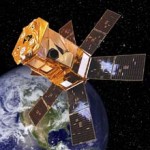SORCE Spacecraft Status

With the loss of another battery cell, SORCE is now operating in a new configuration. While we are working ultimately towards recovering back to normal operations with daily solar irradiance measurements, our current focus is preparing the spacecraft to support a campaign mode to assure overlapping measurements between SORCE and TCTE in December 2013. There will be a data gap for SORCE for several weeks, but we plan to continue the SORCE solar irradiance measurements as soon as it is feasible.
The following lists more details about SORCE status and plans for future operations.
SORCE spacecraft is currently operating in an ‘emergency’ mode.
- SORCE has experienced a cell failure for CPV6 (each nickel hydride common pressure vessel, CPV, has two cells, and SORCE has 11 CPVs). This CPV6 failure caused the end-of-orbit discharge voltage to fall below the voltage level needed for operation of critical flight functions controlled by the Onboard Computer (OBC). This ‘brown-out’ condition causes the system to revert to a spacecraft safe-hold condition under control of a more limited satellite controller called the Attitude and Power Electronics (APE). The APE system controls basic functionality of the spacecraft in safe-hold mode until the OBC is able to resume command.
- Current efforts are in progress at Orbital and LASP for an update to the APE flight software so that safe-hold mode operation does not require 24/7 operations. This update will enable more heating on the orbit day side and turning off non-essential components before the orbit eclipse begins (night side).
- The SORCE flight operations and science teams are now developing new operations and science concepts for the continuation of the mission given the current status of the SORCE power systems.Prior to the onset of the CPV6 failure all the instruments were powered-off during eclipse and making solar measurements during orbit day side. This mode of operation has been on-going for several months prior to the CPV6 failure.
- The key impacts on instrument operations in this power-cycling mode are:
- Larger thermal variations for all instruments – SIM data quality is impacted more than other instruments
- SOLSTICE no longer has stellar calibration observations
- TIM no longer has dark calibrations (night side)
- While these impacts are significant, they do not exclude the acquisition of useable science data. With the current spacecraft performance and software configuration, we believe that future science data acquisition will be limited to times of the year where the eclipse period is less than 23 minutes. This is necessary to keep the end-of-eclipse voltage above 19 volts. These short eclipse periods will limit the data to time periods in June and December where the minimum eclipse duration is about 15 minutes. Consequently, these time periods are the best opportunities for SORCE data campaigns.
- SORCE will perform measurement campaigns in these time periods with priority given to TIM TSI observations to provide overlap with the TCTE mission scheduled for launch in November 2013. As the orbit day side is not power limited, we expect to make SSI measurements by SIM, SOLSTICE, and XPS during these SORCE campaigns.
Following the stabilization of SORCE safe-hold operations for the campaign mode, the effort will focus on returning SORCE back to continuous (daily) science data acquisition. There are two potential paths toward this goal.
- Update operation plans and possibly also MU flight software so solar observations can be performed in Safe Mode. TIM and XPS have large fields of view so useful data could be acquired realtime from them even with poor pointing (+/- 4 degree pointing capabilities in Safe Mode).
- Investigate updating OBC flight software so daily solar observations can be made. For this plan, the OBC, MU, and Instruments will be off in eclipse and then be activated after orbit sunrise and make “normal” solar observations for ~30 minutes when the orbit geometry is favorable. This mode would require downloading data at the end of the contact, as the flight recorders are not available after turning off the OBC prior to orbit sunset.
Finally, the SORCE mission operation team (LASP, OSC, and GSFC) deserves an enormous amount of credit for finding and executing very effective measures to keep SORCE healthy and leading the recovery plans back to continuing solar observations for SORCE.
«Return to the Meetings/News page


